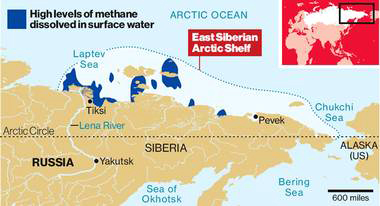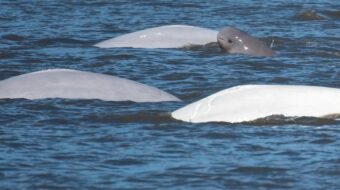
Methane, a greenhouse gas 20 times more powerful than carbon dioxide, has been found by scientists in deadly, bubbling plumes on the surface of the Arctic Ocean.
The scientists, who were undertaking an extensive survey of the area, were utterly bewildered by the scale and volume of the methane. In particular, the head of the Russian research team studying the East Siberian Arctic Shelf’s sea floor for 20 years was completely amazed.
Igor Semiletov, of the Far Eastern branch of the Russian Academy of Sciences, said he has never witnessed such a drastic uptick in methane. He released his findings a few weeks ago at the American Geophysical Union meeting in San Francisco, Calif.
“I was most impressed by the sheer scale and high density of the plumes,” said Semiletov. “Earlier, we found torch-like structures like this, but those were only tens of meters in diameter. This is the first time that we’ve found continuous, powerful, and impressive seeping structures, more than 1,000 meters in diameter. Over a relatively small area, we found 100 [of them]; over a wider area, there should be thousands.”
Semiletov went on to describe the methane as “fountains bubbling through the water column and injected directly into the atmosphere from the seabed.”
“We carried out checks at about 115 stationary points,” he continued, “And discovered methane fields of a fantastic scale – I think on a scale not seen before. Some plumes were a kilometer or more wide, and the emissions went directly into the atmosphere. The concentration was a hundred times higher than normal.”
This is part of a large and very environmentally disastrous occurrence. There are enormous amounts of methane gas trapped beneath the Arctic permafrost, scientists say; hundreds of millions of tonnes’ worth, in fact.
Currently, Arctic sea ice melts with increasing frequency during the summers – putting wildlife there in danger in the process. Coupled with rising temperatures throughout the entire region, the permafrost (which acts as the protective shell that contains these greenhouse gases) is melting. That means that methane trapped inside could be released into the atmosphere and cause rapid climate change – with potentially devastating consequences.
According to the Telegraph, Cambridge University Professor Peter Wadhams said that – as of now – Arctic ice is shrinking with such rapidity that it could vanish altogether within the space of four years’ time. Essentially, by 2015, the report suggested, Arctic ice could be a thing of the past.
Though it would return each winter, its absence the rest of the year would pose a significant threat to – in particular – polar bears, jeopardizing their hunting grounds and actually putting them in real danger of extinction.
The ice’s absence would also encourage oil exploration, which companies are already attempting to pursue, despite strong environmental concerns.
“The fall-off in ice volume,” said Wadhams, “Is so fast that it is going to bring us to zero very quickly. 2015 is a very serious prediction, and I am pretty much persuaded that that’s when it will happen.”
Photo via Independent.












Comments